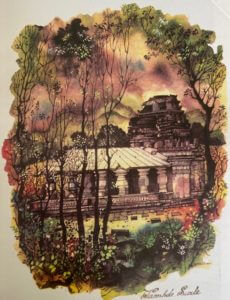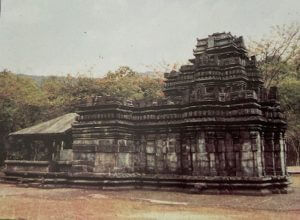 Print This Post
Print This Post

Photo Courtesy: ‘Temples of Goa’ by Kamla Mankekar
Structure:

The only well preserved basalt stone temple as later temples were constructed with laterite stone available plenty in the area. Basalt stone is suitable for very fine intricate carvings. There is no use of mortar in its construction instead the stone is riveted into a stone.
On the outside, the shikhara of the Mahadeva Temple at Tambdi Surla is decorated with just a few small but well carved images in three tiers on each of the three bhadras (the main offsets on the outer walls in each cardinal direction). Unfortunately, the top-tier sculptures on all three sides are destroyed. On the remaining two tiers, the south side has Brahma on the lower tier with Bhairava above; similarly, the west side has Natesha and Uma-Maheshvara and the north side has Vishnu and Lakshmi-Vishnu .
The temple has three entrances from the north, south and east. The main entrance reached by a flight of steps is in the east so that the rays of the rising sun first falls on the deity. The right side entrance door to the shrine has a snake image in the same basalt stone while on the left is a Dwarpala.
The inner design of the temple reflects our approach to spirituality – from the main body to the inner soul thus moving from the spacious pillared hall (mandapa) to the vestibule (antarala) and finally sanctum (garbhagriha).
The mandapa has 14 pillars, 10 plain pillars on the sides and four free standing and well-carved pillars in the central bay. The central ceiling panel of the mandapa has intricately carved eight-petalled lotuses Nandi being placed below the one in the centre. There are four niches (devakoshthas) in the hall decorated with miniature shikharas – which seem to have the same form as the main shikhara of the temple. These niches are on either side of the entrance to the vestibule. At present, the niches to the left of the entrance contain Vishnu and Mahishasuramardini; those to the right, a seated Ganesha and a Naga. There are two more Nagas, an entwined pair. The pillars are monolith and in Hoysala style.
The entrance to the antarala is decorated with perforated panels reminiscent of Hoysala-style screens. The door-frames leading to the sanctum are plain. Ganesha is on the lalatabimba (central panel of the door frame) of the entrance to the sanctum. The lalatabimba serves as an auspicious symbol as well as an indication of the presiding deity inside the temple.
Inside the garbhagriha the Shivalinga is of fairly large proportions and sits on a spacious base. There are other two small Lingas placed against the wall in the background.